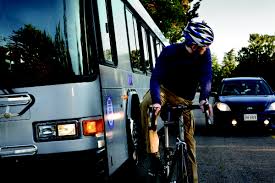Smart Cycling Tips
ABC Quick Check
Before heading out on your bike, it is important and essential to do a quick overview of your bike to make sure everything looks and is working in the way that it's supposed to. The ABC quick check is a fast and easy way to ensure that your bike is in good condition and safe to ride.
- A is for Air: Check to make sure the air pressure in your tires are good. If you are able to easily press into the tires, then they may need some air. When inflating, always check for the P.S.I ( pounds per square inch) to insure that they are being inflated to the right air pressure. Low P.S.I. could lead to the inner-tube being damaged, so always make sure to inflate all the way to the max P.S.I.!
- B is for Brakes: All brakes lose their tension over time, whether it be because of the cables stretching or the brake pads getting worn down. To make sure you have the best braking power, squeeze your brakes check to see that your brake pads make contact with the rim, while still having about an inch and a half of space between the handlebar and the lever. If the lever touches the handlebar when braking or the brakes don't work at all, then you may need to adjust some components. For more info on how to make these adjustments, visit our mechanics page.
- C is for Chain: Before getting on and riding your bike, spin the cranks to make sure that the chain is running smoothly along the chain ring and back cogs. If you have multiple gears in the front and back, check to see if you are able to shift through the gears smoothly. The chain should be lightly oiled and should not have an extensive amount of rust and dirt. You should regularly clean and reoil your chain and make adjustments as needed for the shifting. For more guidance on how to do this, check out our mechanics page or visit us in the shop.
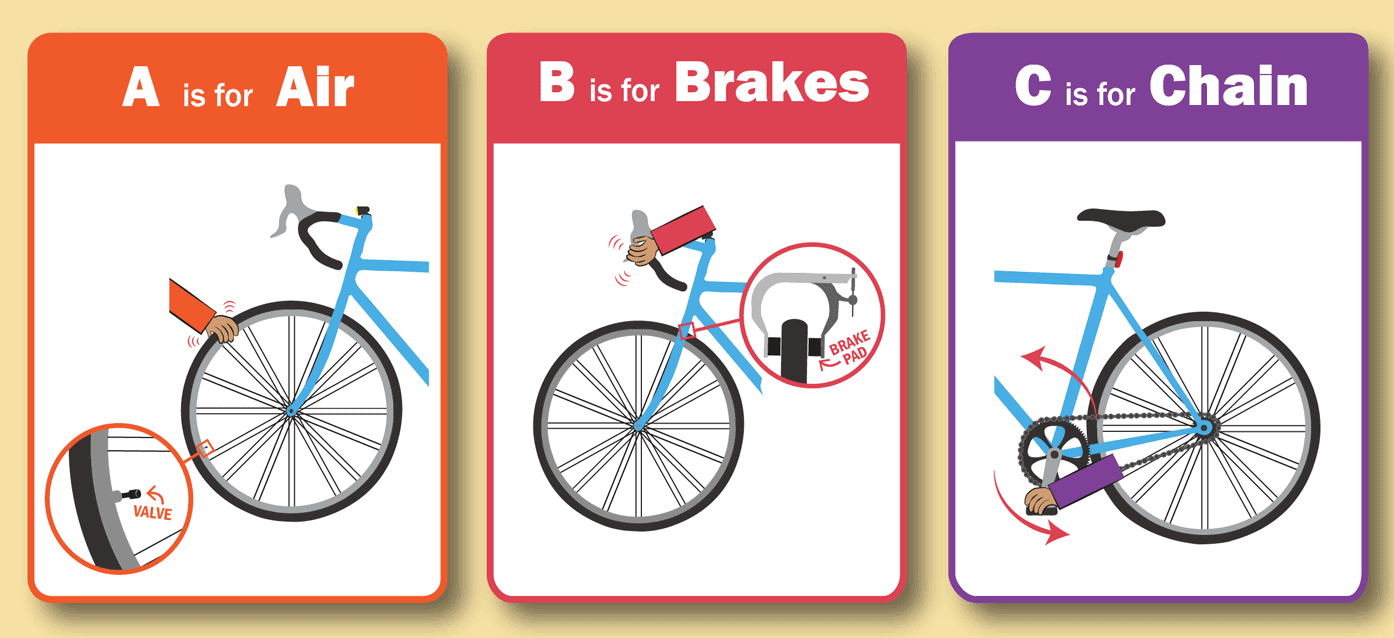
How to avoid collisions
Real bike safety concerns are more than just wearing a helmet and following the traffic laws for cyclists. Avoiding collisions with motorists should be your number one priority when you are biking on the open road. The following diagrams are provided to help you spot and avoid real-world collisions that are potential hazards to your safety.
Types of collisions:
- The right-cross collision
- The door collision
- The crosswalk collision
- The wrong-way collision
- The red light collision
- The right hook collision
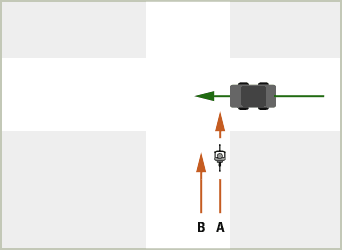 The right-cross collision
The right-cross collision
This is the most common type of bike-car collision according to Bicycling Life and Bicycling Safety. A car is pulling out of a side street, a parking lot, or a driveway on the right hand side and fails to see the cyclist approaching.
To avoid:
- Get a headlight. If you are riding your bike at night, a headlight is an inexpensive option for allowing motorists to see you and your bike more clearly. (It is also the law.)
- Honk. Purchasing an inexpensive (yet, loud) bike horn will allow you to warn motorists that you are approaching.
- Slow down. While slowing down or stopping can be inconvenient, it is certainly a better alternative than getting hit! If you cannot make eye contact with the motorist or if you feel as if they do not plan on stopping, go ahead and slow down for your own safety.
- Ride further to the left. In the diagram to the right you see two lanes of cyclist traffic. Most cyclists travel in lane A to avoid rear collisions. If you approach a possible right-cross collision scenario, try traveling in lane B. The motorist is more likely to see you in this travel lane or you will give yourself more time to speed up or slow down to avoid the collision.
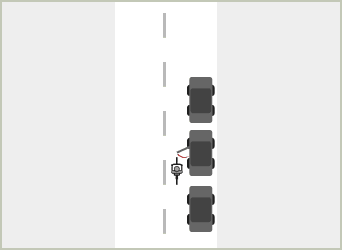 The door collision
The door collision
The door collision is the second-most common type of bike-car collision according to Bicycling Life and Bicycling Safety. The driver of a car opens his door right in front of you. Unable to stop or slow down in time, you run right into the opened door.
To avoid:
- Ride further to the left. You are more likely to collide with an unexpected open door than to be hit from behind by a motorist who can clearly see you. Move over a few feet to the left and you can avoid these unexpected open doors.
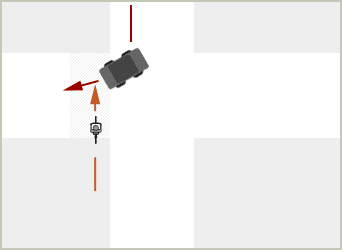 The crosswalk collision
The crosswalk collision
You are riding your bike on a sidewalk and cross the street at a crosswalk. A car is making a right turn at the cross-street and runs into you. Drivers don't expect to see cyclists on the sidewalk or in crosswalks and it is hard for them to see into the crosswalk coming from the previous street.
To avoid:
- Get a headlight. If you are riding your bike at night, a headlight is an inexpensive option for allowing motorists to see you and your bike more clearly. (It is also the law.)
- Slow down. While slowing down or stopping can be inconvenient, it is certainly a better alternative than getting hit! If you cannot make eye contact with the motorist or if you feel as if they do not plan on stopping, go ahead and slow down for your own safety.
- Don’t ride on the sidewalks. Riding your bike on sidewalks makes you more vulnerable to all types of collisions (crosswalk, a car leaving a parking lot, etc.). Riding on a sidewalk can also threaten pedestrians that use them as well. The best way to avoid these collisions and to avoid hurting pedestrians is to ride your bike on the open roadways.
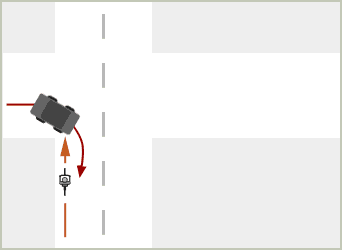 The wrong-way collision
The wrong-way collision
You are riding against traffic on the left-hand side of the road. A car makes a right turn from a side street, parking lot or driveway, right into you. The collision occurred because the motorist checked to the left for oncoming traffic. According to Bicycling Life and Bicycling Safety nearly one-fourth of bike collisions occur because cyclists travel against traffic.
To avoid:
- Don’t ride against traffic! Ride with traffic, in the same direction as motorists.
- Plus, riding against traffic is illegal, and you could be ticketed.
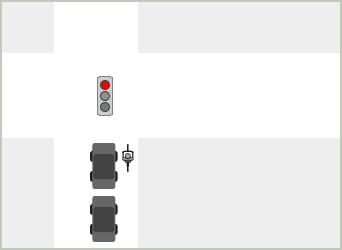 The red light collision
The red light collision
You stop beside a car on the right-hand side that is already stopped at a red light. When the light turns green, you try to continue straight and the motorist makes a right turn, hitting you at the intersection.
To avoid:
- Don't stop in a motorist’s blind spot. Stop directly behind the car. This helps make you visible to traffic on all sides.
- When the light turns green, don't pass the vehicle, remain behind it.
- Never try to pass a car on the right.
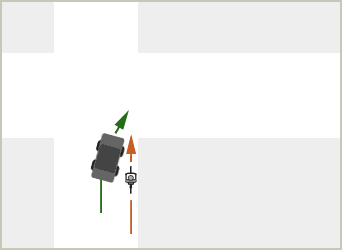 The right hook collision
The right hook collision
A car passes you and then attempts a right turn directly into your path. Motorists tend to think they can "beat out" the cyclist because you are traveling at a slower speed, making this type of collision hard to avoid until the very last second. This type of collision can also happen if you attempt to pass a car (or even another bike) on the right and they make an unexpected right turn.
To avoid:
- Don't ride on the sidewalks. Riding your bike on sidewalks makes you more vulnerable to all types of collisions (crosswalk, a car leaving a parking lot, etc.).
- Ride to the left - in the lane. Taking up the whole lane makes it harder for motorists to pass you, and less likely for this type of collision to occur.
- Use your mirror. Be sure to look in your mirror well before you reach an intersection or crosswalk to determine if any traffic is behind you.
Proper Signaling
When cycling on the road, it's important to make sure you're being as predictable in your direction as possible to other commuters. Predictability and visibility work hand and hand in ensuring your safety on the road, and proper signaling helps with making that possible. Whenever you choose to turn, stop, or change lanes; make sure you are clearly and properly showing hand signals as to effectively communicate your direction to other travelers.
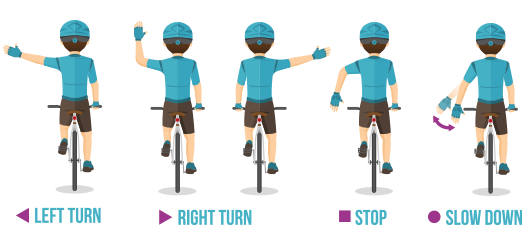
Interacting with the GRTC
The GRTC is a great resource for getting around the city, with or without a bike. If you are looking to going somewhere further away, but are still looking to bike around, all GRTC buses come equipped with an easy to use bike rack out. Click on the image below to see a video on how to use the racks and find out more information about commuting with the GRTC.
For more tips and tricks to safe cycling, check out this Quick Guide to Smart Cycling put together by The League of American Cyclists and pick up a free copy at our shop!
